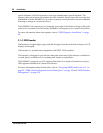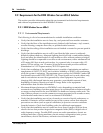
26 Introduction
14117800, Ed.2.6
2.2 Requirements for the KIRK Wireless Server 600v3 Solution
This section provides information about the environmental and electrical requirements
and software requirements for the KWS600v3 Solution.
2.2.1 KIRK Wireless Server 600v3
2.2.1.1 Environmental Requirements
The following is a list of recommendations for suitable installation conditions:
• Verify that the installation area is clean, dry, and protected from weather extremes.
• Verify that the floor of the installation area is finished with linoleum, vinyl, ceramic,
wooden flooring, computer floor tiles, or polished sealed concrete.
• Verify that the ceiling of the installation area is finished or treated to prevent particle
discharge.
• Verify that the installation area is well lit, and that the light source is uniformly
diffused without shadows. Adequate lighting should provide a comfortable reading
level and allow the identification of wire insulator colors without undue eye fatigue.
Lighting should be comparable to an office work environment, with a minimum level
of 21 meter/68.9 feet at each work surface. As a general rule, in a room with a 2.5
meters/8.2 feet ceiling, one 1.2 meters/4 feet fluorescent tube provides sufficient
illumination for 1.9-2.4 square meters/20.5-25.9 square feet.
• Verify that ventilation of the installation area is capable of maintaining an ambient
temperature of 0-40°C/32-104°F, and a relative humidity of 20-80% non-condensing,
while the system is operating. The maximum power rating of a KWS600v3 under full
load should not exceed 315W/1070 BTU/Hr. These figures are for each cabinet only,
and do not take into account heat generated by other equipment. In particular,
charging fully-discharged batteries may generate a considerable amount of heat,
depending on battery capacity and rate of charge. Refer to the equipment
manufacturer data for more information.
• Maximum distance between two KWS600v3 varies depending on material and
construction of buildings, but there must always be synchronization chains and radio
coverage overlap between the two KWS600v3 or handover between radio units. The
time it takes a person to cross the common coverage area must be 10 seconds or more,
as the handset needs time to scan for an alternative KWS600v3.
• Verify that the installation area is free of caustic or corrosive liquids, substances, or
materials. If batteries will be installed as part of the system, ensure that adequate
precautions are taken (such as special ventilation) to prevent corrosive emissions
from the batteries. Check local building codes for additional requirements.
• Verify that the installation area is located no closer than 6.1meters/20.0 feet from
electric devices that produce large electro-magnetic fields (EMF) or high levels of
radio frequency energy. Possible EMF sources are radio transmitters, electric arc
welding machines, copying machines, electric motors, refrigeration units, power
transformers, electric load centers, and main circuit breaker panels.


















